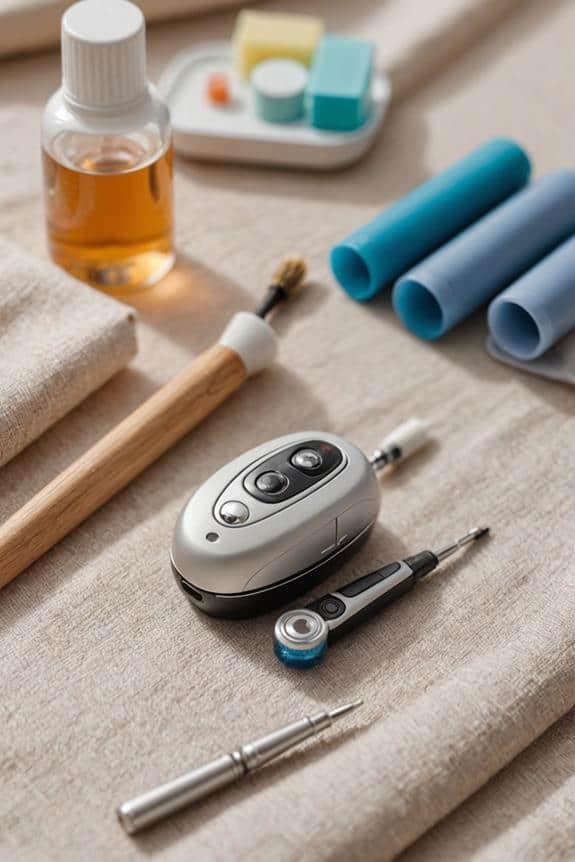To clean your hearing aids effectively, follow these steps:
- Use a soft brush and dry cloth to remove any wax and debris.
- For ITE models, focus on microphone ports and change wax filters every 3-4 weeks.
- If you have BTE devices, inspect the casing daily and wash domes in soapy water.
- Always handle hearing aids over soft surfaces to prevent drops.
- Verify your hands are clean and dry before cleaning.
By maintaining a regular cleaning routine, you'll enhance sound quality and prolong the lifespan of your devices. There's even more useful information available on proper care methods.
Importance of Cleaning Hearing Aids
Cleaning your hearing aids is essential for maintaining their performance and guaranteeing you get the best sound quality possible. Regular cleaning prevents the accumulation of wax and dirt, which can obstruct sound delivery and diminish your overall hearing experience. The warm and moist environment of your ear makes routine maintenance important, as it creates a breeding ground for debris that can lead to issues over time.
Incorporating a consistent maintenance schedule into your routine offers several health benefits. By regularly cleaning your hearing aids, you reduce the risk of infections caused by microbial changes associated with accumulated debris. This proactive approach not only protects your hearing aids but also safeguards your ear health, allowing you to enjoy clear and uninterrupted sound.
Here are some key points to reflect on regarding the importance of cleaning your hearing aids:
- Optimal Performance: Regular cleaning helps guarantee your hearing aids function at their best, enhancing sound quality.
- Prolong Lifespan: Routine upkeep can greatly extend the life of your devices, reducing the need for costly repairs or replacements.
- Clear Sound Quality: A clean hearing aid allows you to fully appreciate sounds, making conversations and other auditory experiences more enjoyable.
Cleaning Techniques and Tools
One of the best ways to secure your hearing aids perform at their best is by using effective cleaning techniques and tools. Regular maintenance is essential, and developing a consistent cleaning frequency can greatly enhance your hearing aids' lifespan and performance.
Start by using a soft brush and a dry cloth to gently remove wax and debris from the body, sound port, and domes of your hearing aids. This simple step guarantees ideal sound quality. If you have In-the-ear (ITE) hearing aids, pay special attention to the microphone ports. A soft-bristle brush works wonders here, while a wax pick can help clear out any stubborn particles in the openings.
For the thin tubes and domes, unscrew them and wipe them down with a damp cloth. A black cleaning rod is also handy for removing moisture and debris. Aim to change the wax filters in your ITE hearing aids every three to four weeks. This prevents wax buildup that could hinder performance.
Consider investing in a MultiTool designed specifically for hearing aids. This tool typically combines a brush, wax loop, and other cleaning aids, making your maintenance schedule more thorough. By incorporating these techniques and tools into your routine, you'll not only keep your hearing aids clean but also guarantee they deliver the sound quality you expect. Regular attention to cleaning will make a noticeable difference in your daily experience with hearing aids.
Caring for Different Hearing Aid Types
Different hearing aid types require specific care to guarantee peak performance and longevity. When it comes to BTE maintenance, daily cleaning is essential. Start by inspecting the outer casing and tubing for any debris. Clean the domes and earmolds with warm, soapy water, making sure to remove the earmold for a thorough wash. Always dry it completely overnight to avoid moisture-related issues. Additionally, remember to replace the tubing every six months to guarantee ideal sound quality.
For ITE upkeep, focus on the microphone ports and filters. Change the wax filter every three to four weeks to prevent build-up that can affect sound clarity. Use a soft-bristle brush to gently clean the openings and microphone ports, making sure you don't push dirt further into the device.
Here's a quick reference for caring for your hearing aids:
BTE Maintenance:
- Inspect and clean the outer casing daily.
- Wash domes and earmolds in warm, soapy water.
- Replace tubing every six months.
ITE Upkeep:
- Change wax filter every 3-4 weeks.
- Use a soft-bristle brush for microphone ports.
Always handle your devices over a soft surface to minimize drop damage, and make sure your hands are clean and dry before cleaning. By following these care practices, you'll keep your hearing aids functioning properly and enhance their lifespan.
General Care Tips
To keep your hearing aids in top condition, develop a routine that includes regular cleaning and proper storage. A well-structured cleaning schedule is crucial for daily maintenance, ensuring your devices perform at their best. Here are some key care tips to follow:
- Regularly clean your hearing aids using a soft cloth to remove dirt and moisture. This simple step helps maintain their performance and longevity.
- Store them properly in a clean, dry case when not in use. This protects your hearing aids from dust and potential damage.
- Avoid moisture exposure by removing your hearing aids before swimming, showering, or applying hair products. Moisture can severely impact their functionality.
In addition to these tips, regularly inspect and replace wax filters and domes to prevent blockages that can affect sound quality. It's crucial to keep your hearing aids away from extreme temperatures; avoid leaving them in pockets during cold weather or near heat sources, as this can harm their internal components.
Additional Support Resources
Exploring additional support resources can greatly enhance your experience with hearing aids. Taking advantage of local hearing centers is one effective way to receive professional advice. These centers often provide hearing tests and tailored maintenance tips to guarantee you get the most out of your devices. Authorized professionals can also supply you with accessories, spare parts, and cleaning tools specifically designed for your hearing aid model, making upkeep simpler and more effective.
For specialized support, contemplate consulting certified Oticon hearing care professionals. They possess the expertise to guide you through any concerns or questions you may have about your hearing aids, guaranteeing you maintain peak performance.
In addition to in-person resources, don't overlook the wealth of information available through online resources. You can find tutorials, maintenance guides, and forums where users share experiences and tips. These resources can greatly enhance your understanding of proper cleaning techniques and troubleshooting methods.
Here's a quick list of support resources to ponder:
- Local Hearing Centers: For professional advice and hearing tests.
- Authorized Professionals: Access to tailored accessories and tools.
- Certified Oticon Professionals: Specialized support for your specific needs.
- Online Resources: Tutorials and forums that offer guidance and community support.
Frequently Asked Questions
What Is the Best Thing to Clean Hearing Aids With?
For effective cleaning methods, use a soft, dry cloth daily to wipe your hearing aids. Incorporate maintenance tips like using a cleaning brush for debris and replacing wax filters every few weeks for ideal performance.
How Do I Clean the Wax Out of My Hearing Aid?
To tackle wax removal, use a soft brush and wax pick for effective cleaning. Always keep your hands clean and dry while handling the device, ensuring you're using the right cleaning tools for best results.
Is It OK to Clean Hearing Aids With Alcohol Wipes?
You shouldn't use alcohol wipes for cleaning hearing aids due to alcohol safety concerns. Instead, clean them regularly with a soft cloth. Following the proper cleaning frequency guarantees your devices remain in good condition.
How to Clean NHS Hearing Aids?
To clean NHS hearing aids, follow NHS guidelines by wiping the exterior daily and using a soft-bristle brush for openings. Change wax filters every three to four weeks for peak performance. Consistent cleaning frequency matters.





